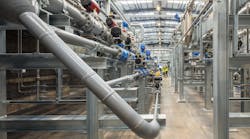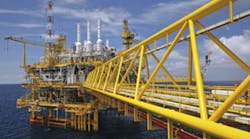Multiphase flowmeters (MPFMs) provide continuous real-time measurement of unprocessed hydrocarbons. From the mid-1980s, they have been used for oil and gas production optimization, hydrocarbon allocation and to control the technical integrity of oil and gas production facilities.
More recently, some fiscal measurement applications began to appear too. Currently, there are more than 6,000 MPFMs in use globally, with field operators using them to reduce capital and operational expenditure and to increase production efficiency. Some of these meters are installed within existing infrastructure (e.g., test separator), while others are being used as the primary measurement point for new fields or to realize cost benefits in the exploitation of marginal fields.
MPFMs play a key role in addressing well performance by measuring the well rates and ultimately bringing an increase of the reservoir final recovery factor. Accurate flow measurement near the wellhead enables users to make informed decisions about critical operational procedures, such as optimization of reservoir characteristics, enhanced recovery techniques, first water breakthrough and the mitigation of pipeline flow assurance challenges.
Conventional measurement techniques using test separators are believed to offer superior stability and measurement confidence in comparison to MPFMs. However, a well’s behavior can change significantly between scheduled well tests. In addition, the single-phase measurement advantages — if complete separation between the phases is obtained — come with higher capital and operational costs, along with much less flexibility for the complex field architectures seen in some of the subsea environments today. Well test-based validation methods are often viewed as inappropriate due to their excessive cost and large associated infrastructure. In addition, modern production alternatives, e.g., subsea processing, make using these traditional verification methods even more complex.
Real-time and continuous production monitoring is one key advantage of MPFMs, along with data gathering, for process workflows that support production optimization. However, unlike single-phase meters, MPFMs rarely (if ever) return to a calibration facility after initial installation due to cost and installation issues. Thus, there is a recognized need to address the challenges of validating MPFMs in-situ throughout their time in service.
As industry continues to exploit deeper and more remote fields, and with the tieback of marginal fields owned by different companies to a main production line, the lack of in-situ verification of MPFMs will become increasingly more significant. Moreover, well testing through a test separator will become less feasible in such situations.
However, the use of MPFMs in oil and gas applications, particularly when installed in remote or subsea environments, is not without challenges. In subsea applications, the expectation is that MPFMs are installed for permanent and continuous use with no intention of periodic removal for calibrations. In these circumstances, validation of the measurements becomes vitally important, as they may be used in the allocation of revenues from the produced fluids, and even marginal errors can lead to significant financial exposure.
Single-phase meters generally use a transferable reference calibration performed annually at a qualified laboratory. The closest thing to a reference calibration for an MPFM would be to validate it against a well test. However, well tests can provide only a limited degree of validation for several reasons. MPFMs and test separators generally operate at different pressure and temperature; therefore, correlations through equations of state — pressure, volume and temperature (PVT) software — are needed to relate the volumetric flow rates at MPFM and test separator location.
MPFM technologies are sensitive to different types of salts or electrochemical properties of the produced fluids, while separators are not. In addition, mass versus volume-based measurements require careful consideration over which PVT model to use to convert mass flow rates to volumetric flow rates or to pass from line conditions to standard conditions. Continuous input into data acquisition systems of oil in water and water in oil contamination is needed. Moreover, the gas-oil ratio (GOR) is typically not measured in a well test; therefore, the gas flow rates of an MPFM cannot be reliably validated.
There are also cases where test separators are not a suitable validation technique simply for logistical reasons, and sampling might be the next best option. However, to be of any value, samples must be representative of flowing conditions, which can be difficult to achieve. Subsea sampling is costly and labor intensive and therefore a less attractive option for MPFM in-situ verification.
Some questions need to be seriously addressed to improve the reliability of MPFMs. Will the meter still perform in a changed (more extreme) environment? Is the PVT still representative years later? Are the fluid properties the same throughout the years? PVT models are used in MPFM flow computers to convert the fluid volumes at MPFM conditions to those closer to standard conditions further downstream. This is a critical aspect of the MPFM validation process, as PVT correlations can lead to significant uncertainties if incorrect.
Various PVT models are often applicable to a specific type of well or field. Often, different PVT models will yield different results for the same situation. Sometimes, manufacturers will do a lab analysis of the produced fluids during well startup to define a PVT correlation that is tailored to their specific fluid properties. However, fluid properties are subject to change over time, therefore deviating from the initial PVT specification.
MPFMs are commonly deployed in extreme conditions, enduring high pressures, high temperatures, highly corrosive contaminants, erosion and heightened susceptibility to solid deposition. These variables, as well as the volumes of the primary fluids themselves, are subject to change over time and must be accounted for to minimize measurement uncertainty.
While ensuring that the ongoing performance of MPFMs is critical to avoid the financial exposure and risks associated with their mismeasurement, to date, there is a need to address the challenges associated with their ongoing maintenance and calibration in-situ for both topside and subsea installations. A valid and fit-for-purpose in-situ verification method is required to ensure accurate measurements are obtained on an ongoing basis. To this end, TÜV SÜD National Engineering Laboratory has been engaged in a two-year long internal research program that addresses the key challenges facing the global industry and aims to put in place various measures and practices to help reduce their impact.
In-situ verification will still require either a comparison with another flow measurement system or the use of diagnostics to estimate the quality of the measurements being taken on a continuous basis. The exact method is not defined yet and will likely consist of a mixture of the two methods. Further research and development work is required to find a solution that is viable for industry.
As part of the U.K. Government’s Industrial Challenge Strategy Fund, TÜV SÜD National Engineering Laboratory’s new research program is working on the development of in-situ verification methods for industry and is performing research to find a robust solution. As traditional calibration methods become increasingly unviable due to excessive cost and logistical problems and as ever deeper and more remote fields are exploited, the research work will help to establish clear industry guidance to improve measurement uncertainty in the field, reduce financial exposure and increase confidence in the use and deployment of multiphase meters.



